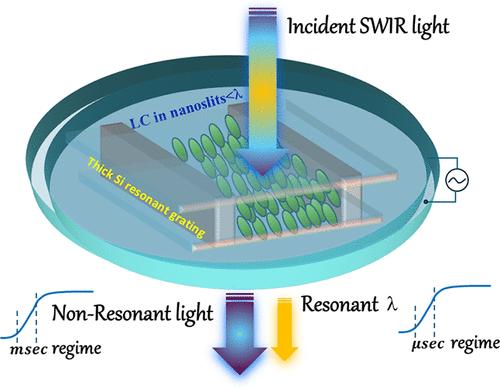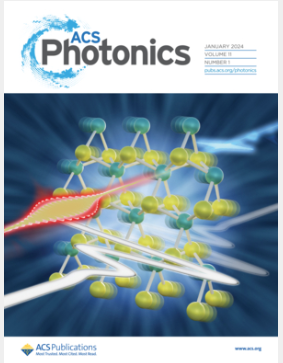利用局部电磁场增强纳米腔中液晶的速度和可调性
IF 6.5
1区 物理与天体物理
Q1 MATERIALS SCIENCE, MULTIDISCIPLINARY
引用次数: 0
摘要
向列型液晶(lc)的速度通常受到粘弹性弛豫时间的限制,粘弹性弛豫时间由粘度、弹性常数和器件厚度决定。在这里,我们将LC限制在谐振纳米腔中,并设计电磁场集中在LC的特定区域内,在该区域内分子对施加电压产生强烈反应,从而打破了这一限制。将LC限制在712 nm高、566 nm空间的亚波长深硅(Si)光栅内,实现了导模共振,在共振波长处LC空间中心产生了高场约束。相反,在共振波长之外,场约束转移到Si线。这种结构减少了一个数量级的上升时间,从2 ms到200 μs的共振波长。优化后的LC空间中心场重叠积分表明,大部分光-物质相互作用发生在该区域。因此,这个中心区域比整个LC区域对增加的电压的响应更快,从而解释了在共振时观察到的更快的响应。同样,如果纳米空腔内部的排列得到更好的控制,则可以增强对电压和温度的响应可调性。这种方法为利用更快的LC模式和创新的谐振纳米腔设计的超快器件铺平了道路。本文章由计算机程序翻译,如有差异,请以英文原文为准。

Enhanced Speed and Tunability of Liquid Crystals in Nanocavities via Engineering the Local Electromagnetic Field
The speed of nematic liquid crystals (LCs) is usually limited by the viscoelastic relaxation time, determined by the viscosity, elastic constant, and device thickness. Here, we demonstrate breaking this limit by confining the LC in a resonant nanocavity and designing the electromagnetic field to be concentrated within a specific region of the LC where the molecules react strongly to the applied voltage. Confining the LC within a subwavelength deep silicon (Si) grating of 712 nm height and 566 nm space, we achieve a guided mode resonance that results in high field confinement at the center of the LC space at the resonance wavelength. Conversely, outside the resonance wavelength, the field confinement shifts to the Si lines. This configuration reduces the rise time by an order of magnitude, from 2 ms to 200 μs at the resonance wavelength. The optimized field overlap integral at the center of the LC space indicates that most of the light–matter interactions occur in this region. As a result, this central region responds faster to an increasing voltage than does the entire LC region, thereby explaining the faster response observed at resonance. Similarly, the tunability in response to voltage and temperature can be enhanced if the alignment inside the nanocavities is better controlled. This method paves the way for ultrafast devices that utilize faster LC modes and innovative resonant nanocavity designs.
求助全文
通过发布文献求助,成功后即可免费获取论文全文。
去求助
来源期刊

ACS Photonics
NANOSCIENCE & NANOTECHNOLOGY-MATERIALS SCIENCE, MULTIDISCIPLINARY
CiteScore
11.90
自引率
5.70%
发文量
438
审稿时长
2.3 months
期刊介绍:
Published as soon as accepted and summarized in monthly issues, ACS Photonics will publish Research Articles, Letters, Perspectives, and Reviews, to encompass the full scope of published research in this field.
 求助内容:
求助内容: 应助结果提醒方式:
应助结果提醒方式:


